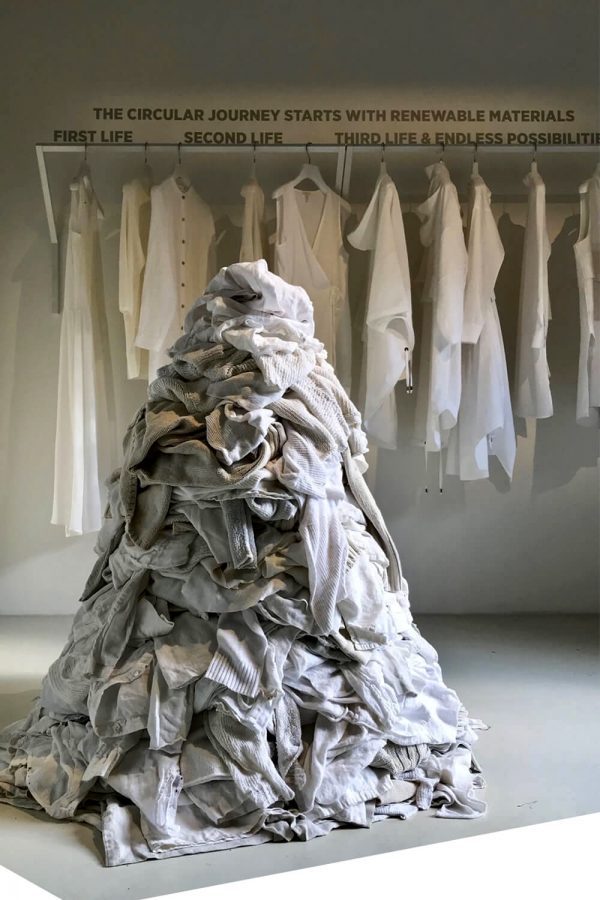Discussing the ethical and sustainability factors among the clothing brands Shein and CHNGE

More stories from Meghan Kennedy
Booming with an array of colors, patterns, fabrics, and styles, the daily lives of many people are enveloped in clothing and fashion trends. Over the years, many clothing companies have established their own unique styling to represent their brand and have turned into epicenters of trends. But living in a high-speed world with perpetually disposable trends also means high-speed fashion—more commonly known as fast fashion.
Being a teenager, I have purchased clothing from stores and websites that have been known for fast fashion and have felt guilty afterwards. I do not want to support companies that have no empathy towards their workers or the environment. However, there is little control over how ethical we can shop as teenagers, simply because we are still reliant on our parents and can’t afford to make big purchases on clothing when our financial concern lies on our futures.
Accordingly, those of lower socioeconomic statuses don’t have many options when it comes to ethical and sustainable fashion, so it is easiest to turn to fast fashion in order to find cute clothes at cheap prices that do not cause an excess of damage to their wallets. And while that in itself is reasonable and expected, fast fashion still is not.
While many brands like H&M, Forever 21, and even Urban Outfitters are guilty of fast fashion, one of the main companies under fire and stands out in this matter is Shein. From cultural appropriation, unethical working conditions, and blatant use of hate symbols, Shein has done it all.
Shein was founded in 2008 and has spread to over 220 countries since then. Their so-called philosophy that they have stuck by throughout the years is “everyone can enjoy the beauty of fashion.” This is by no means is a bad philosophy because everyone should be allowed to enjoy fashion in its beauty and be free to express themselves in the way they choose. But the fact that they don’t pay their workers enough to even get by does not bode well for that statement. Though Shein has pledged to protect the rights of their employees, there has been little to no information on that subject whatsoever. In fact, they have barely even spoken or let any information out about their working conditions at all; presumably, this is because they are trying to cover it up. Despite the lack of intel shared by Shein, former workers have spoken up about their experience working in these sweatshops and the explotation they have experienced. Further clues that point towards this are the very poor quality of Shein’s clothing. When the quality is lacking, that is a big indicator of workers having to pump out hundreds of garments on the daily, which is unacceptable.
Other than their unjust supply chain and treatment of employees, Shein is at fault for a tremendous environmental impact. Because the quality of the clothes is not up to par, that means that a majority of the products will be sent to the landfill sooner or later. Additionally, as a result of their high-speed production, the trends they pick up on and design for will die out quickly which leads to more items being tossed in the trash. All this does is contribute to the overflowing of landfills and negatively affecting the health of the environment.
Moreover, Shein factories rapidly consume water and energy and emit an excess of greenhouse gases into the atmosphere. This resulted in Shein’s rating of “very poor” and “we avoid” in terms of the environment, ethical production, and treatment of animals by the brand rating website “Good on You.” Shein is just one big pollution machine, to put it bluntly.
And regarding their cultural appropriation and use of hate symbols, don’t even get me started. They sold Islamic prayer rugs as decorations and also sold swastika necklaces as an accessory labeled as “cute.”
On the complete opposite end of the spectrum, the clothing brand CHNGE lays gracefully. From feminism, size inclusiveness, environmental concern, and racism, CHNGE tackles all topics through their garments. Being the activist company they are, their main goal is promoting sustainable fashion that carries deeper messages and meanings.
On their website, CHNGE has specific tabs to show their factories and what their clothing is made and sourced from. They completely direct their attention to leave no room for harm to their workers or the environment.
According to a Forbes article, “They know specifically where the cotton for each and every t-shirt or hoodie comes from down to the exact field.” Moreover, CHNGE pays their workers a livable wage and teaches them how to manage their money and income. To boost their positive impact even further, CHNGE donates fifty percent of its profits to select charities such as the Malala Fund, Pencils of Promise, Stand for the Trees, and more (Meet CHNGE: The Ethical Clothing Brand Set Out to Impact The World).
And just one more great thing about CHNGE is their modeling campaign. They find their models solely based on their alignment with the companies beliefs and not because of their looks. Their models span from a variety of different body sizes and shapes, skin tones, hair types, skin conditions, and etnicities. They don’t necessarily go for conventional models or specific “high-fashion” looks, per se. CHNGE strives to be the change in all senses of the word while normalizing and representing real people while they are it.
In comparison to Shein’s exceptionally low prices, the average cost of a CHNGE t-shirt hones in at around $33 dollars and the average sweatshirt is priced at about $69. And yes, this is on the more expensive side, but this is a result of high-quality and ethical production. Shein on the other hand sells the average t-shirt for a whopping $10, along with sweatshirts for about $14. The clear route might point to picking Shein for purchasing clothing, but their unethical practices and unfortunate quality I mentioned before will lead to a heavier cost in the future. If a CHNGE item can last for years upon years while supporting the environment and maintaining sustainability, that is the greater investment.
I am not saying that everyone altogether should boycott all companies that perpetuate fast fashion. It just wouldn’t be reasonable, or quite frankly, possible. Not every person has access or the ability to purchase all clothing from ethical and sustainable brands, so large clothing companies are the stores to turn to while on a budget. But I think that, in order to lend a hand to the environment and the mistreated workers at stake, we should do our part to contribute less to companies like Shein.
Shopping exclusivley from brands like CHNGE, however, is not the protocol—there are many thrift and second-hand stores that provide cute styles and items that directly support local businesses and companies that strive for the betterment of others. For example, Goodwill, Salvation Army, or Plato’s Closet are all great second-hand stores for shopping at here in Grand Rapids. Another benefit of upcycling clothing is that the environment is not affected whatsoever—there is no further production of clothing because all pieces were previously produced. The fewer materials used, the less harm done.
While the environmental state of the world is unstable, promoting sustainability and ethics among clothing companies is a minor alteration contributing to a more environmentally friendly lifestyle. Although it seems minuscule, it is still playing a part to save the planet and the ones within it.

Meghan. also known as Meggie, is living up her senior year on The Central Trend. Starting out with a new role as Podcast Manager, Meggie is looking forward...



























































































